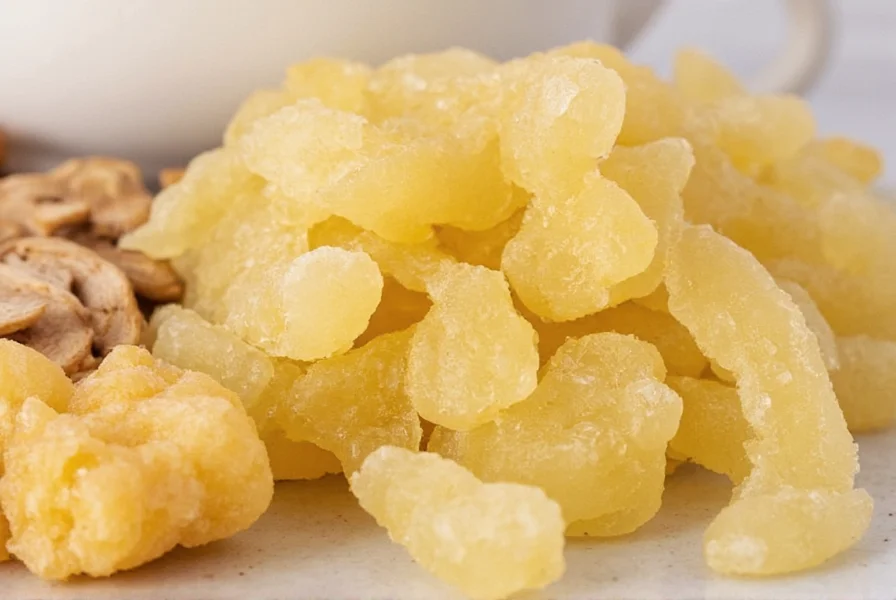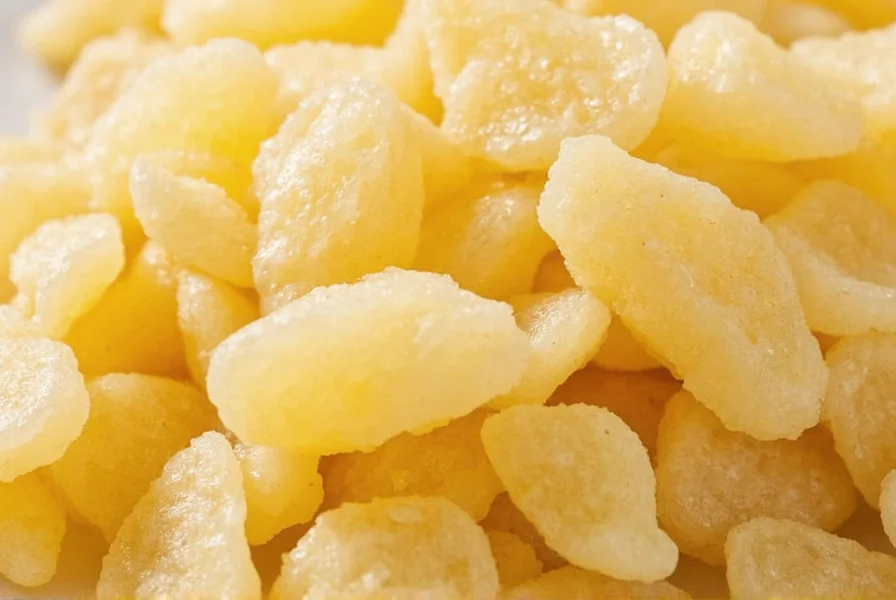Crystallized ginger transforms the pungent root into a shelf-stable treat through a preservation process that maintains its distinctive flavor profile while adding sweetness. This versatile ingredient bridges the gap between medicinal remedy and culinary delight, finding its way into both traditional medicine cabinets and modern bakeries.
What Exactly Is Crystallized Ginger?
Crystallized ginger, also known as candied ginger or stem ginger, undergoes a specific preparation method. Fresh ginger root slices simmer in sugar syrup until the rhizomes absorb the sweet liquid and become tender. Manufacturers then drain and roll the pieces in coarse sugar, creating the characteristic crystalline coating. This preservation technique dates back centuries, originally developed as a method to extend ginger's usability beyond its short fresh shelf life.
The production process significantly alters ginger's chemical composition. While fresh ginger contains approximately 60% water, crystallized versions reduce this to about 20%, concentrating certain compounds while introducing sucrose. This transformation creates a product with distinct properties compared to its fresh counterpart.
Nutritional Profile Comparison
| Nutrient (per 1 oz) | Crystallized Ginger | Fresh Ginger | Dried Ground Ginger |
|---|---|---|---|
| Calories | 100 | 19 | 80 |
| Carbohydrates | 26g | 4g | 18g |
| Sugar | 22g | 0.2g | 0.3g |
| Gingerols | Moderate | High | Concentrated |
| Fiber | 1g | 0.2g | 2g |
This nutritional comparison reveals why crystallized ginger vs fresh ginger presents different considerations for various uses. The sugar content makes crystallized versions higher in calories but preserves the ginger's active compounds in a more stable form.
Health Benefits and Considerations
Research suggests health benefits of crystallized ginger primarily relate to its gingerol content, though in lower concentrations than fresh ginger. Clinical studies indicate potential benefits for:
- Nausea relief, particularly for motion sickness and morning sickness
- Moderate anti-inflammatory effects
- Digestive support through stimulation of saliva and bile production
- Mild antioxidant properties
A 2022 review in the Journal of Ethnopharmacology noted that while crystallized ginger contains less active compounds than fresh, its convenience and palatability often lead to more consistent consumption, potentially offsetting the lower concentration. However, individuals monitoring sugar intake should consider crystallized ginger nutritional value carefully due to the added sucrose.
Culinary Applications and Usage Tips
How to use crystallized ginger in cooking spans multiple culinary traditions. Its sweet-spicy profile makes it ideal for:
- Baking: Chop finely for cookies, cakes, and breads
- Confectionery: Incorporate into chocolates or caramels
- Glazes: Mince and add to sauces for meats
- Tea: Steep pieces in hot water for soothing ginger tea
- Cocktails: Use as garnish or muddle into drinks
When substituting in recipes, remember that crystallized ginger provides both sweetness and spice. For savory dishes requiring ginger's heat without sweetness, fresh or ground ginger works better. For dessert applications, crystallized ginger often delivers superior texture and controlled sweetness.
Storage and Shelf Life
Proper storage significantly extends does crystallized ginger go bad timeline. Keep it in an airtight container away from light and moisture. Under ideal conditions:
- Pantry storage: 6-12 months
- Refrigerated: 12-18 months
- Freezer: Up to 2 years
Signs of spoilage include excessive hardening, mold growth, or off odors. Sugar bloom (a white coating) typically indicates sugar crystallization rather than spoilage and remains safe to consume.
Homemade Crystallized Ginger Recipe
Creating making crystallized ginger at home allows control over sugar content and quality. Follow this simple method:
- Peel and slice 1 cup fresh ginger into 1/8-inch pieces
- Simmer in 2 cups water for 30 minutes until tender
- Drain, then simmer in 1.5 cups sugar syrup (1:1 sugar:water) for 45 minutes
- Drain pieces, reserving syrup for tea
- Toss in 1/2 cup coarse sugar until coated
- Dry on wire rack for 24 hours
This homemade version typically contains less sugar than commercial products and avoids preservatives. The reserved syrup makes excellent ginger tea base for crystallized ginger for nausea relief.

Quality Selection Guide
When purchasing crystallized ginger, look for:
- Translucent pieces rather than opaque (indicates proper syrup penetration)
- Flexible texture (hard pieces suggest overcooking)
- Minimal additional ingredients beyond ginger, sugar, and sometimes citric acid
- Organic certification if pesticide concerns exist
Higher quality products maintain ginger's natural fiber structure and deliver balanced sweet-spicy flavor without overwhelming sugar dominance.
Frequently Asked Questions
Is crystallized ginger as healthy as fresh ginger?
Crystallized ginger contains lower concentrations of active compounds like gingerols compared to fresh ginger due to the cooking process and added sugar. However, its convenience often leads to more consistent consumption. For therapeutic purposes requiring maximum potency, fresh ginger remains superior, while crystallized offers a palatable alternative for regular use.
Can crystallized ginger help with nausea?
Yes, crystallized ginger can provide nausea relief, particularly for motion sickness and morning sickness. The gingerols remain active through the crystallization process. Many travelers and pregnant women find the convenient, pre-portioned pieces easier to use than fresh ginger. For best results, consume 1-2 pieces (about 1 gram total) 30 minutes before potential nausea triggers.
How does crystallized ginger differ from dried ginger?
Crystallized ginger retains more moisture (about 20%) compared to dried ground ginger (5-8% moisture). The crystallization process preserves ginger's fibrous structure while adding sugar, creating a chewy texture. Dried ginger powder offers more concentrated flavor and active compounds but lacks the textural element. Crystallized works better in applications requiring visible ginger pieces, while dried excels in spice blends and rubs.
Can I substitute crystallized ginger for fresh in recipes?
Substitution requires adjustments. Use 1 tablespoon minced crystallized ginger for every 1 tablespoon fresh ginger, but reduce added sugar elsewhere in the recipe by 1-2 teaspoons per tablespoon substituted. Remember that crystallized ginger provides sweetness along with spice, making it better suited for desserts than savory dishes where fresh ginger's pure heat is desired.
Why does my crystallized ginger become hard over time?
Crystallized ginger hardens when moisture evaporates. To restore softness, place a slice of apple or bread in the container overnight to reintroduce moisture. Alternatively, microwave individual pieces for 5-10 seconds. Proper storage in an airtight container with minimal air exposure prevents excessive hardening and extends shelf life.











 浙公网安备
33010002000092号
浙公网安备
33010002000092号 浙B2-20120091-4
浙B2-20120091-4